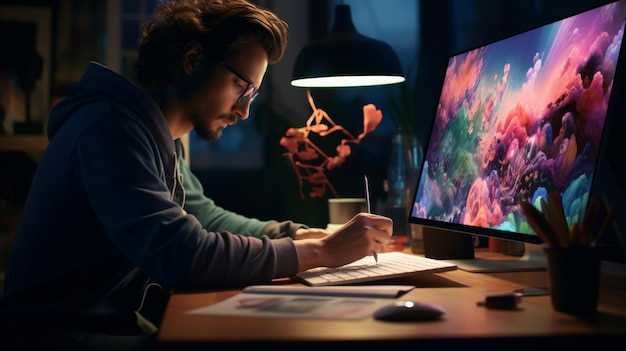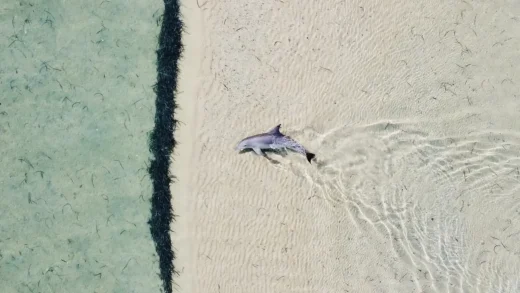
In the ever-evolving realm of digital art, there lies a mesmerizing domain where imagination takes flight and animations come to life. Delving into this captivating world gives rise to a myriad of possibilities, where artists push the boundaries of their creativity to craft visually stunning masterpieces that captivate and enchant their audience. This article embarks on a journey through various animation techniques and styles, delving deep into the enigmatic art form that seamlessly blends technology, storytelling, and pure artistic expression.
From the whimsical charm of traditional hand-drawn animation to the cutting-edge magic of 3D computer-generated imagery, the art of animation encompasses a vast array of styles and techniques. Each approach holds its own unique allure, offering artists a plethora of tools to convey their stories and emotions. Whether it is the lively movement of characters rendered frame by frame or the seamless integration of computer-generated elements into a live-action film, animation holds the power to transport viewers into captivating and enchanting worlds.
Like a symphony conductor skillfully orchestrating every note, animators meticulously craft each scene, meticulously breathing life into their creations. The artistry lies not only in the movement itself but also in the subtle nuances that evoke emotions and immerse viewers in a palpable atmosphere. It is in the delicate gestures, the play of light and shadow, and the careful choreography of each frame that the art of animation truly shines, transcending the boundaries of reality and evoking a profound sense of wonder.
Exploring the Evolution of Animation Techniques
In this section, we will delve into the historical development of animation, tracing its evolution from its early beginnings to the advanced techniques used in modern animation. We will explore the various stages of innovation and the transformation of animation over time, highlighting the key milestones and breakthroughs that have shaped the art form.
1. Origins of Animation
To understand the evolution of animation, we must first explore its origins. Animation can be traced back to ancient times, where early civilizations experimented with simple forms of motion through cave paintings and visual storytelling techniques. These primitive animations provided the foundation for the development of more complex methods in the future.
Throughout history, different cultures and civilizations have utilized various methods to bring motion to still images, including thaumatropes, phenakistoscopes, and zoetropes. These early techniques laid the groundwork for the future advancements in animation.
2. Technological Advancements
The evolution of animation techniques took a significant leap forward with the advent of new technologies. The invention of photography and the subsequent development of motion picture cameras revolutionized the animation industry. The ability to capture and project a sequence of images created the basis for modern animation.
Subsequent breakthroughs, such as the invention of celluloid sheets and the development of hand-drawn animation, brought new possibilities to the art form. Techniques like cel animation allowed animators to create more complex and fluid movements, giving birth to iconic animated characters and stories.
3. Digital Revolution
The digital age brought about a revolution in animation techniques. With the introduction of computer-generated imagery (CGI), animators gained access to powerful tools and software that enabled them to create realistic and immersive animations. This digital transformation also made it possible to combine traditional animation techniques with digital effects, pushing the boundaries of what can be achieved in animation.
The evolution of animation techniques continues today, with advancements in technology and the emergence of new forms of animation, such as stop-motion, claymation, and 3D animation. These developments open up new creative possibilities and allow animators to explore different styles and storytelling techniques.
- Key milestones in animation evolution:
- The invention of thaumatrope in the early 19th century.
- The first animated film, “Fantasmagorie,” created by Émile Cohl in 1908.
- The release of “Snow White and the Seven Dwarfs,” the first full-length animated feature film, by Walt Disney in 1937.
- The introduction of computer-generated animation in “Toy Story,” the first fully CGI-animated feature film by Pixar in 1995.
In conclusion, the evolution of animation techniques has been a fascinating journey of innovation and creativity. From its humble beginnings to the technological advancements of today, animation continues to captivate audiences worldwide with its ability to bring imagination to life.
From Traditional Cel Animation to Digital Animation
In this section, we will explore the evolution of animation techniques from the traditional method of cel animation to the modern digital animation process. We will dive into the different processes, tools, and artistic styles involved in both approaches, highlighting their unique characteristics and advantages.
- Transition from Hand-drawn to Digital
- Evolution of Animation Tools
- Distinctive Features of Cel Animation
- Advantages and Limitations of Digital Animation
- Emergence of Hybrid Animation Techniques
Over time, animation has seen a significant shift from the manual creation of each frame on individual cels to the utilization of computer software and graphics tablets. This transition has brought about numerous changes in the way animations are produced and has opened up a world of creative possibilities.
The development of digital animation tools has revolutionized the industry, enabling animators to work more efficiently and experiment with new styles and techniques. However, traditional cel animation has its own charm and distinctive qualities that continue to captivate audiences.
We will delve into the characteristics of cel animation, such as the fluidity of hand-drawn movements, the vibrant colors achieved through hand-painted cels, and the tactile texture that gives each frame a unique appeal.
On the other hand, digital animation offers advantages like precise control over each element, the ability to easily make edits and adjustments, and the flexibility to explore a wide range of visual styles. However, it also presents challenges as it requires mastering complex software and techniques.
A noteworthy development in recent years is the integration of traditional and digital animation techniques, resulting in hybrid approaches. This fusion allows artists to combine the best aspects of both methods, creating captivating animations that push the boundaries of artistic expression.
As we embark on this exploration, we will gain a deeper appreciation for the rich history and evolution of animation, discovering the diverse techniques and approaches that continue to shape the art form today.
Innovations in Stop-Motion Animation
Advancements in the realm of stop-motion animation have brought about exciting developments and groundbreaking techniques, transforming this art form into a captivating medium of storytelling. This section will delve into the latest innovations in stop-motion animation, exploring how creators have pushed the boundaries of traditional techniques to breathe new life into their projects.
One notable innovation in stop-motion animation is the integration of digital technology. By combining the tactile nature of physical models with computer-generated imagery (CGI), animators are able to achieve seamless blends and enhanced visual effects. This fusion of digital and practical elements allows for a more expansive and dynamic animation style, captivating audiences with its intricacy and attention to detail.
Another groundbreaking technique that has revolutionized stop-motion animation is the use of replacement animation. Rather than manipulating physical models frame by frame, this method involves substituting individual parts or components to create fluid movements. By swapping interchangeable elements like facial expressions or limbs, animators can achieve more precise and expressive character animations, making the storytelling experience even more engaging.
| Advancements in Stop-Motion Animation |
|---|
| Digital Technology Integration |
| Replacement Animation Technique |
In addition to technological advancements, the innovation of materials and tools has also played a crucial role in the evolution of stop-motion animation. With the introduction of new materials such as lightweight plastics and flexible resins, animators are able to create more lifelike and expressive characters. The availability of advanced armature systems and 3D-printing technology further facilitates the intricate movements and detailed articulation required for seamless animations.
Furthermore, the advent of motion control systems has undoubtedly pushed the boundaries of stop-motion animation. These automated systems allow for precise camera movements and repeatable actions, enabling animators to achieve complex, multi-layered scenes with ease. Through the integration of motion control, the storytelling possibilities in stop-motion animation expand, offering creators more control and unlocking new levels of creativity.
In conclusion, the innovations in stop-motion animation have brought about a new era of storytelling and artistic expression. With the integration of digital technology, replacement animation techniques, advancements in materials and tools, and the introduction of motion control systems, animators continue to break new ground and captivate audiences with their unique and imaginative creations.
Discovering the World of Computer-Generated Imagery (CGI)
In this section, we will embark on an exciting journey into the vast realm of Computer-Generated Imagery, commonly known as CGI. By delving into this captivating art form, we will explore a multitude of visually stunning creations and uncover the magic behind its creation.
CGI revolutionizes the way we perceive animation and visual effects, bringing imagination to life with exceptional realism. Through the use of sophisticated algorithms and advanced software, CGI artists manipulate virtual objects, environments, and characters to craft immersive and breathtaking cinematic experiences.
Within the realm of CGI, a world of boundless creativity awaits. From fantasy realms populated by mythical creatures to futuristic cities teeming with technological marvels, CGI allows filmmakers, game designers, and animators to manifest their wildest ideas and transport audiences to extraordinary worlds.
One of the most remarkable aspects of CGI is its ability to seamlessly blend with live-action footage, constructing seamlessly integrated scenes that defy reality. By skillfully combining real actors and practical sets with computer-generated elements, filmmakers can achieve astonishing visual feats that were once unimaginable.
With every leap forward in CGI technology, artists and filmmakers continue to push the boundaries of what is possible. From the development of hyper-realistic simulations to the creation of mind-bending abstract animations, CGI constantly evolves, contributing to the ever-expanding universe of visual storytelling.
In conclusion, the discovery of the captivating world of Computer-Generated Imagery opens up a realm of infinite possibilities for animators, filmmakers, and enthusiasts alike. Through CGI, we can explore fantastic worlds, experience breathtaking visual effects, and witness the transformative power of technology in the world of animation.
Exploring 2D and 3D Animation: Similarities and Differences
Comparing and contrasting 2D and 3D animation opens up a world of artistic possibilities, showcasing the similarities and differences between these two captivating forms of visual storytelling. Both techniques utilize animation to bring characters and objects to life, yet they employ distinct methods to achieve their unique effects. While 2D animation relies on the creation of flat, two-dimensional drawings, 3D animation introduces depth and realism through the use of three-dimensional models.
| 2D Animation | 3D Animation |
|---|---|
| Focuses on creating hand-drawn or computer-generated images in a two-dimensional space. | Utilizes three-dimensional models, rigging, and computer algorithms to manipulate objects in a virtual three-dimensional environment. |
| Offers a stylized and often more simplistic visual appearance, relying on techniques such as cel shading or traditional frame-by-frame animation. | Provides a more realistic and immersive visual experience by simulating lighting, textures, and camera movements. |
| Traditionally used in traditional hand-drawn cartoons, advertisements, and certain video games. | Commonly employed in modern feature films, video games, and architectural visualizations. |
| Allows for greater artistic freedom in terms of exaggerated movements and distortion. | Offers more control over realism and cinematography, allowing for precise camera angles and lifelike animations. |
| Requires skilled animators to bring characters to life through hand-drawn illustrations and frame sequencing. | Relies on a team of modelers, riggers, animators, and texture artists to create and animate complex three-dimensional objects. |
Despite their differences, both 2D and 3D animation have proven to be powerful tools in the world of visual storytelling, captivating audiences with their unique visual styles and lifelike movements. Whether it’s the charm and nostalgia of 2D animation or the immersive realism of 3D animation, both techniques continue to evolve and push the boundaries of artistic expression.
The Emergence of Motion Graphics in the Production of Animated Content
In recent years, the field of animated content production has witnessed a significant rise in the utilization of motion graphics. This innovative approach to animation has revolutionized the way visual messages are conveyed, offering a dynamic and engaging experience for audiences. Motion graphics refer to the art of combining text, graphics, and animation to create visually compelling content that effectively communicates ideas and concepts.
One of the reasons behind the growing popularity of motion graphics in animation production is their versatility. This technique allows animators to incorporate various elements such as typography, illustrations, and even video footage seamlessly. As a result, motion graphics have become a powerful tool for storytelling, enabling animators to convey complex information in a visually captivating manner.
Moreover, motion graphics offer a unique blend of style and creativity. Animators can experiment with different visual effects, transitions, and color schemes to create dynamic and visually stunning animations. This flexibility allows for the creation of diverse animation styles, ranging from sleek and minimalistic designs to vibrant and energetic compositions.
The rise of motion graphics has also been fueled by advancements in technology. With the availability of powerful animation software and tools, animators now have greater control and efficiency in creating motion graphics. This accessibility has democratized the production process, allowing animators of different skill levels to explore and push the boundaries of animation.
In conclusion, the emergence of motion graphics in the realm of animation production marks a transformative shift in visual storytelling. This technique offers animators a versatile and creative approach to conveying complex ideas through engaging visuals and dynamic animations. As motion graphics continue to evolve and gain further recognition, it is clear that they will play an integral role in shaping the future of animated content.



